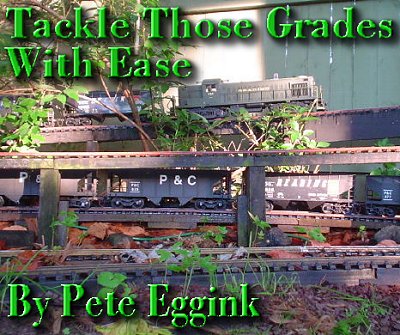 | |||
 |
 |
 | |
 |
 | ||
 |
 | ||
 |  | ||
 |  | ||
 | |||
 |
 |
 | |
 |
 | ||
 |
 | ||
 |  | ||
 |  | ||
Written by Paul D. Race for Family Garden Trains(tm)
 |
|
|
Editor's Note: In railroading terms, "grade" refers to how steeply the track rises or falls. Grade is usually measured in percentages. For example a route that raised one foot per every hundred feet of length would be on a 1% grade. For garden railroaders who want to run long trains and improve reliability, I usually recommend a maximum of a 2% grade for the average mainline, then having the scenery rise and fall around your trains. This gives the effects of grades without causing your train to strain up one hill and careen down the next. But people sometimes do need or want to include steeper grades, so I am pleased to provide this article by Pete Eggink. It was originally published in the members-only newsletter of the Southeast Pennsylvania Garden Railway Society in October, 2004. It is also still available, with many of Pete's other informative articles on his own site. Needless to say, all graphics and text are used by permission - Paul Tackle Those Grades With Ease by Pete EgginkOften our garden railroad tracks have to climb up and down hills, just like the real railroads. This can make for some real challenges. How steep can it be? How does this affect the trains? First we’ll take a look at how the real railroads deal with these challenges and then how we deal with them in our garden railroads.
The Pennsylvania Railroad went up and over the mountains, building the famous Horseshoe Curve to route trains up to the summit. The New York Central had more miles but the Pennsy had to deal with the grades. Calculating GradientIn the U.S., grades are described in percent gradient, meaning how many feet rise in elevation per 100 feet of track. A level track is zero percent; a one-foot rise per 100 feet is a 1% grade; a two-foot rise per 100 feet is a 2% grade, and so on.In general, railroads keep their grades as low as possible to keep operating expenses down. Heavy grades take their toll on fuel, maintenance, number of locomotives, helper crew costs, and slower schedules. A long stretch of 1% is considered a heavy climb (the Feather River Canyon for instance), but there are many places where grades are steeper than this. Grades on Famous Mountain Crossings The Pennsylvania Railroad tackled the Alleghenies between Altoona and Gallitzin by winding the railroad around the hills and valleys to achieve more track length. This kept the grade at a manageable 1.75%, but it still requires helpers to this day. The Baltimore and Ohio was not so fortunate. Its West End route from Cumberland, MD to Grafton, WV, had FOUR long, winding grades of 2.2%.The Rio Grande’s main line across Colorado had to tackle a big 3% grade up to Tennessee Pass. But their narrow gauge routes were even tougher: many mountains had to be crossed with 4% grades. One of these 4% grades is still tackled every day by the Cumbres and Toltec Scenic Railroad. The Southern Railway had a route (now closed) that climbed Saluda Mountain at 4.7%. The steepest mainline grade in the U.S. was the Madison Incline, pulling out of the Ohio River Valley at a whopping 5.89% grade. The Cass Mountain Railroad had a maximum grade of 11% where Shays were used to pull empty log cars up the mountain and loaded ones down. You can ride the same route today. There are a few cases of railroad grades even steeper on which locomotives climbed with the help of geared rails (cog railroads) or cables (often called planes). The Mount Washington Cog Railroad has a maximum grade of 37.5% and still uses steam engines. The Mahanoy Plane of the Reading had a 22% grade and pulled one or two cars at a time up or down the hill. It was eliminated in the 1930’s when the railroad built a long tunnel instead. How Railroads Deal With Grades
Grades on Garden RailroadsFor garden railroads, grades are often necessary. But there are cases where the builder has a choice. Here is what I would recommend:
Measuring Grades on Your Garden RailroadHere’s a quick-and-easy method to measure grades. Take a 24-inch level and a set of ¼-inch shims of wood. Set the level on the track and raise the lower end with the shims until the bubble’s in the center. One shim is 1%, two shims are 2%, and so on.
Percent Grade = millimeters/6.1 With the level’s bubble centered, the track rises 18.3 mm. So the grade here is 3.0%. ConclusionYou can see that planning and calculating grades is pretty easy. And you have some idea of what you can "get away with" for various kinds of trains. Best of luck with your planning. If you want to get ahold of me, contact Paul, and he'll forward your e-mail.
|



|

| 
|
 |
 |
 |
 |
 |
Note: Family Garden TrainsTM, Garden Train StoreTM, Big Christmas TrainsTM, BIG Indoor TrainsTM, and BIG Train StoreTM are trademarks of Breakthrough Communications (www.btcomm.com). All information, data, text, and illustrations on this web site are Copyright (c) 1999, 2000, 2001, 2002, 2003, 2004, 2005, 2006, 2007, 2008, 2009, 2010, 2011, 2012, 2013 by Paul D. Race. Reuse or republication without prior written permission is specifically
forbidden.
Family Garden Trains is a participant in the Amazon Services LLC Associates Program, an affiliate advertising program designed to provide a means for sites to earn advertising fees by advertising and linking to amazon.com.
For more information, please contact us

 |  |